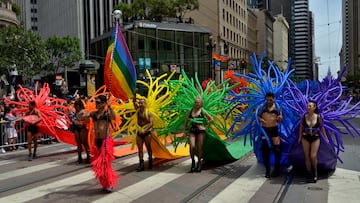Why is San Francisco the most important city in the USA for LGTBIQ+ Pride Month?
A look at the many reasons San Francisco became a haven for the LGBTQ community in the 20th century and how the community continues to leave its mark on the city.


On Sunday, June 30, San Francisco will host its annual LGBTQ Pride Parade. The SF Pride Parade is one of the largest in the world and attracts over one million attendees.
The Bay Area’s largest city has a long history connected to the LGBTQ community, and that rich history is on full display throughout June. The city has long been seen as a haven for LGBTQ people, which led the population to grow over the course of the 20th century. The Castro, the historically gay neighborhood, continues to be a space for free expression. However, the explosion of Silicon Valley has taken its toll on the city, raising rent prices to astronomical levels and pricing some community members out of the city. In 2015, CBS released a report that showed that the number of people moving to the Castro was beginning to fall. Very little data exists on the current residents and how the neighborhood has shifted over the last decade.
But when did Castro start to attract gay men? Well, in the 1940s, the US military was not friendly to the idea that gay soldiers could serve and discharged thousands of men, mainly from the Pacific Theater in World War II, and many of them chose to settle in the Bay Area. Slowly, as the word spread and a community established itself, more and more people began to journey west. ‘White flight’ also occurred in the area as many white families looked to purchase property in the suburbs or in more upper-class areas of the city. Their leaving left cheaper real estate available for newcomers, allowing those who made the Castro their home the freedom to establish businesses and give the neighborhood their unique character.
Solidarity emerged out of the darkness
It would be a mistake to think it was all sunshine in rainbows for the LGBTQ community in San Fransisco in the second half of the 20th century. Though the city was the first to elect an openly gay member to the San Francisco Board of Supervisors, Harvey Milk was killed less than a year after beginning his term.
His death in 1978 came just a few years before the HIV/AIDS epidemic would decimate the gay population, destroying the lives of those abandoned by the government, which refused to act to protect them, and the survivors who watched their friends perish at rates that would cast a shadow over the rest of their lives. According to the San Francisco Chronicle, between 1981 and 2016, more than 20,000 people died of AIDS in the city.
The public health crisis, for which the lack of action by the federal government should not be excused or forgotten, forced the LGBTQ community to come together to care for one another. Some medical professionals who saw through the homophobia and fear of the unknown disease worked with the community to establish centers for care. Organizations like the San Francisco AIDS Foundation, which started operating as a volunteer-based organization in 1982, helped to lead efforts to educate the public about the threat of AIDS before scientists had even given it a name.
Related stories
Organizations like this began to work with state officials and medical professionals who would listen to offer treatment to patients who became infected, many of whom tragically died, as there was very little that could be done at the time. Now, these organizations work both on reducing the transmission rate of HIV and by ensuring that those infected know that there are medications. One of them is PREP, an anti-viral, that can allow them to live normal lives where the risk of transmitting the virus falls to nearly zero percent.
The strength of the LBGTQ community and its continued presence in San Francisco are testaments to the solidarity exhibited by its members and continued by younger generations who honor those traditions and continue to build their own.
Complete your personal details to comment